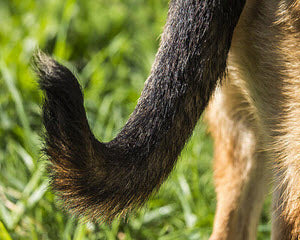If only dogs could talk, you say? Well, they don’t speak in words, but they do have a very instinctual language to tell us how they feel. They use doggie body language. And the more we learn to recognize their way of communicating, the more we’ll be able to understand what they are telling us.
Some simple, obvious signs are a wagging tail or a vicious growl. It’s not hard to know they’re happy or upset at those moments. But did you recognize the subtle signs leading up to those behaviors?
Key States of Mind
There are four key mindsets that affect how a dog behaves. They are aggressive, submissive, timid and excited. Sometimes two states of mind may intersect, such as timid-aggressive behavior. An example of this would be a fearful dog that bites someone who is entering their personal space. The list below will help you interpret your dog’s body language.
- Tense Tail – A tense tail is an indication your dog is in a state of unrest. The tail might also be wagging, but if the tail is high and rigid, you’ll want to steer clear. Take action to pinpoint what is upsetting your pooch.
- Closed Mouth – Much like the stiff body tail wagging, a closed mouth indicates that something is holding your dog’s attention. If it is another dog, be prepared that it might escalate to aggressive behavior.
- Raised Hair on Back – Your dog might love to rough house with other dogs. The vocal ones could also seem to be growling or hurting each other. The best way to tell if it is playful-aggressive or angry-aggressive is to see if the hair on his back, right behind the head, is raised and stiff. If so, it is a sign your dog is angry or in an aggressive state.
Submissive:
- Relaxed Tail – A relaxed tail shows your dog is relaxed and passive.
- Looks Away – Dogs will show trust, especially around people, by looking away. They’ll also display this passive behavior around non-threatening animals.
- Exposed Belly – Besides just loving more belly rubs, this position indicates trust and submission. You will see this behavior when a dog feels intimidated by an alpha dog.
- Licks Lips or Nose – Functionally, dogs will lick their noses to keep it moist for smelling, but it is also an indication of being nervous or anxious.
- Tail Between Legs – A cowering head and tail are signs of fear or shame. The tail between the legs is showing he’s trying to be as small as possible.
- Yawns – If your dog is uncomfortable about something, he may yawn which is a way of removing internal tension.
- Shivering – Trembling and shivering can indicate everything from your dog being sick to being over-the-top excited. Determine if your dog shivers quite often or only in certain situations. Trembling around certain people may be a sign of past trauma.
- Eyes Wide Open / Body Tense – When their eyes are wide open and the body is tense, it is another sign of fear.
- Ears Pinned – You will usually see this along with the tail between the legs. It is a sign of being scared.
- Full Body Tail Wag – It’s a joy to watch your dog in a full body tail wag. It’s an unmistakable sign of pure excitement.
- Tail Up in the Air – Generally speaking, the higher the tail points, the more excited he is. A high tail when walking or playing is a sign of enjoyment.
- Eyes Wide Open / Body Moving – This time if the eyes are extremely open but the body is fluid and moving, it is a sign of being overly excited.
Sounds
In addition to body cues, you can tell a lot from the sounds your dog is making. As you get more in tune with your dog, your ear will be able to interpret their sounds and know what it means.
- Groan / Yawn – Some dogs are just more vocal than others. Often when stretching or relaxing their body, you may hear these groans of delight.
- Growl – If their teeth are exposed when growling, it can be a warning sign or form of aggressiveness and intimidation. If the teeth aren’t exposed, it could just be a form of aggressive-playfulness.
- Barking – Barking can mean a number of things. Watch for other clues to see what he is trying to tell you. Generally, one bark is an alert sign. Multiple barks mean your dog is trying to tell you something and wants your attention.
- Yipping – Dogs usually yip when they’re uncomfortable or lonely. New puppies will yip because they miss their moms and are uncomfortable in your home. You may also hear yipping when you leave or put them in their kennel.
- Jumping to Greet You – Besides being really excited to see you, they jump up to try to kiss you, another sign of affection.
- Chewing – More common when they’re puppies, but if your dog continues it could be a sign of anxiety or with certain breeds it could just be what they do to relax and get comfortable.
- Climbing on the Couch – When up on the couch, if your dog climbs up on the back, it may be trying to get higher than you. This means he is trying to exert a position of authority or dominance over you.
- Panting – It’s probably not because they’re tired or exhausted, but just trying to get their bodies cool. Panting expels heat from their bodies. When you see them panting, try to get them in the shade or inside to cool down.
A Deeper Relationship
The more time you take to learn your dog’s language, the deeper bond you will create between you and your dog. Remember, no two dogs are alike. A signal might mean one thing with your dog, but not the same thing in another dog. It’s always a good practice to approach with caution when you don’t know a dog. Watch for signs of aggressiveness to keep yourself and your family members safe.
This blog is brought to you by Under the Weather™, provider of products for sick pets.
View Our Products
Visit Our Blog Library









